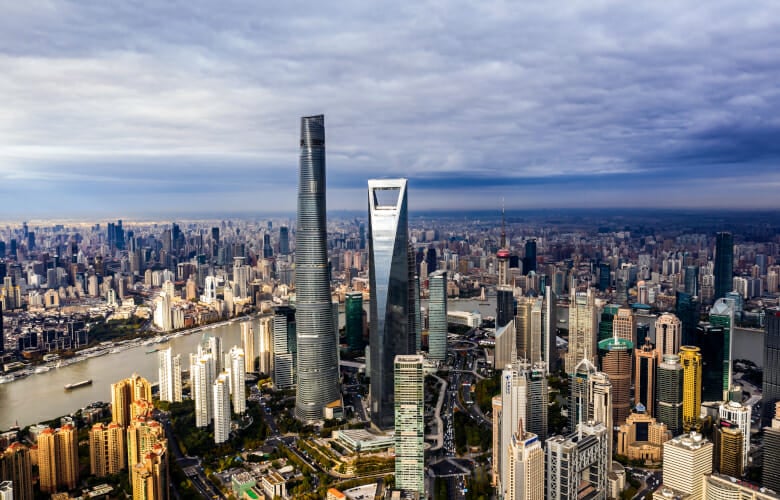
Shanghai’s office market outlook remains gloomy
Prime office rents in Shanghai plunged 9.9 percent in the second quarter from a year prior, according to a Knight Frank report released Wednesday, as vacancy continued to hover near two-decade highs amid sluggish leasing demand and a supply overhang.
Average prime office vacancy in the mainland Chinese commercial hub edged up to 20.8 percent from 20.1 percent in the first quarter, while average monthly rents fell 3.6 percent over the same period to RMB 228 per square metre.
Shanghai saw the second-largest year-on-year drop in rents among major Asia Pacific office markets, behind Beijing’s 11.1 percent decline, as oversupply and new building completions weighed on the market. The city has some 23 million square metres of vacant office space, according to Savills, with a further 8 million square metres of projects expected to enter the market before 2030.
“Landlords prioritising occupancy levels in Chinese mainland markets have continued to exert downward pressure on rents in the region,” said Christine Li, head of Asia Pacific research at Knight Frank. “With the pace of decline picking up faster, the search for a bottom in these markets still has some way to go.”
Downturn Continues
On a blended basis, prime office rents in mainland China’s tier 1 cities of Shanghai, Beijing, Guangzhou and Shenzhen plunged 10.8 percent year-on-year last quarter, accelerating from a 10 percent decline in the first quarter, with Hong Kong also sliding 8.8 percent over the same period, according to Knight Frank.

Christine Li, head of Asia Pacific research at Knight Frank
That compares to year-on-year rental growth of 5.1 percent, 3.5 percent, 2.9 percent and 0.5 percent in Sydney, Seoul, Singapore and Tokyo, respectively.
Office absorption in Shanghai improved as some occupiers took advantage of the falling rents and influx of new supply to upgrade to newer projects or relocate away from core areas in an effort to reduce costs. The city logged positive net absorption of 115,700 square metres in the second quarter, nearly double the level achieved in the prior quarter, according to a JLL report released this month.
“In the central business districts, tenants leveraged market opportunities to upgrade office quality by relocating to newer projects, while the cost saving decentralisation trend continues,” said Stanley Jiang, senior director of Shanghai office leasing advisory for JLL.
Professional services firms accounted for the largest share of leasing demand last quarter, accounting for 45 percent of new space, followed by firms in the manufacturing and technology, media and telecommunications sectors, which respectively took up 23 percent and 15 percent of newly leased area, according to Cushman & Wakefield.
Vacancy in core commercial districts averaged 15.8 percent in the second quarter, with Lujiazui and Jing’an district seeing the highest leasing demand in the city with respective vacancies of 11.6 percent and 12.6 percent. That compares to 14.3 percent in Huangpu district, 16.7 percent in Xuhui, and 28.1 percent in non-core suburban areas, according to the consultancy.
Lost Decade
Shanghai’s bleak market comes as advisory firm Oxford Economics in May warned of a “lost decade” in mainland China’s office market after consecutive years of falling rents, record vacancy, and deteriorating investor confidence drove values of office assets in the country down as much as 30 percent from peak levels.
“Despite the prevailing global headwinds, China’s office markets have been flooded with new supply, evidenced by higher vacancies relative to other global markets,” Nicholas Wilson, Oxford Economics’ associate director of Asia real estate economics said in a report. “All major cities across China currently have vacancy rates above 20 percent, with nearly half of the major cities exceeding 30 percent. This means China has the highest vacancy rates of all major markets globally.”
Shanghai Lujiazui Development Group, the state-backed builder which developed much of the city’s Lujiazui financial district, said in its annual report released in April that Shanghai’s office market faces a “long-term correction”. The developer controlled by the Pudong district government is seeking buyers for 20 Shanghai office towers in the Lujiazui area and the Qiantan International Business Zone on the east side of the Huangpu River.
In May, a joint venture controlled by New York’s Rockefeller Group agreed to sell a pair of office buildings in Shanghai’s Bund area to insurer ZhongAn Online P&C Insurance, after average grade-A office vacancy in the waterfront district rose to 16.1 percent from 13.2 percent in 2021.
Shanghai’s office market slump has also motivated US investment management giant BlackRock to put on the market a pair of office buildings in the city’s Putuo district at a 30 percent discount to what it paid to acquire the properties six years ago.

Leave a Reply